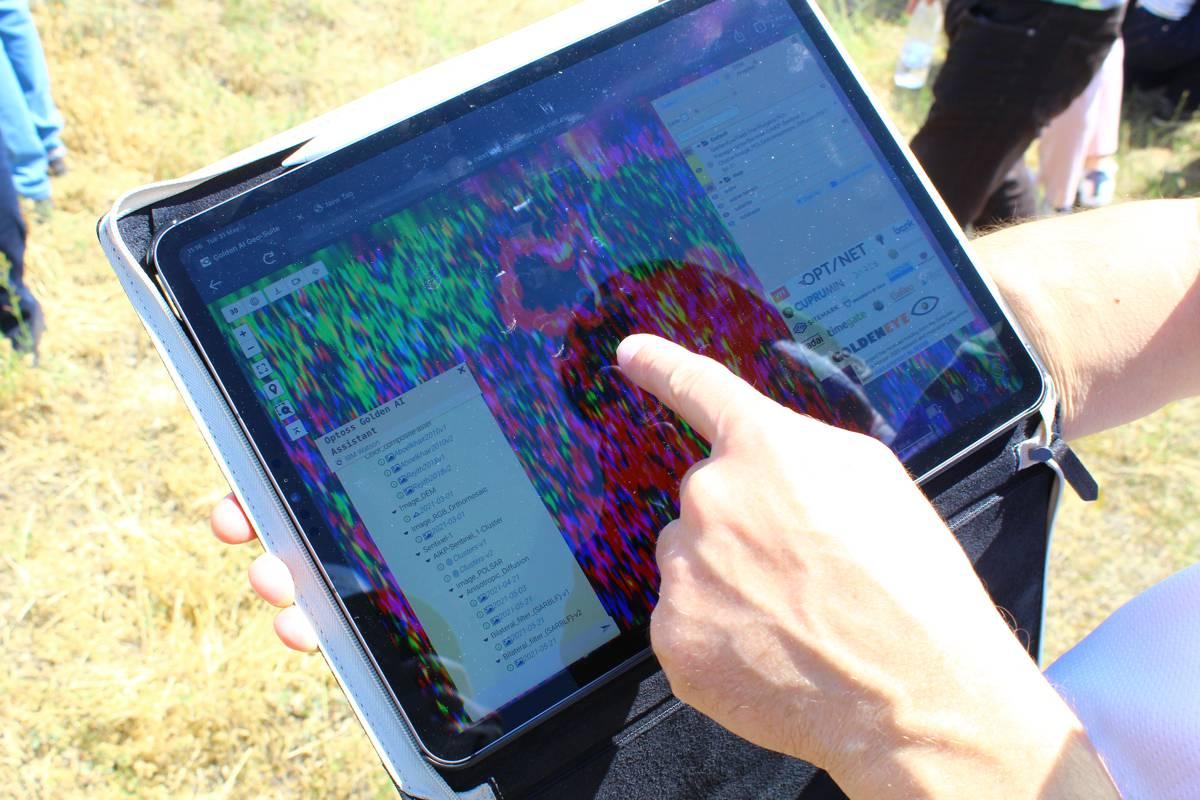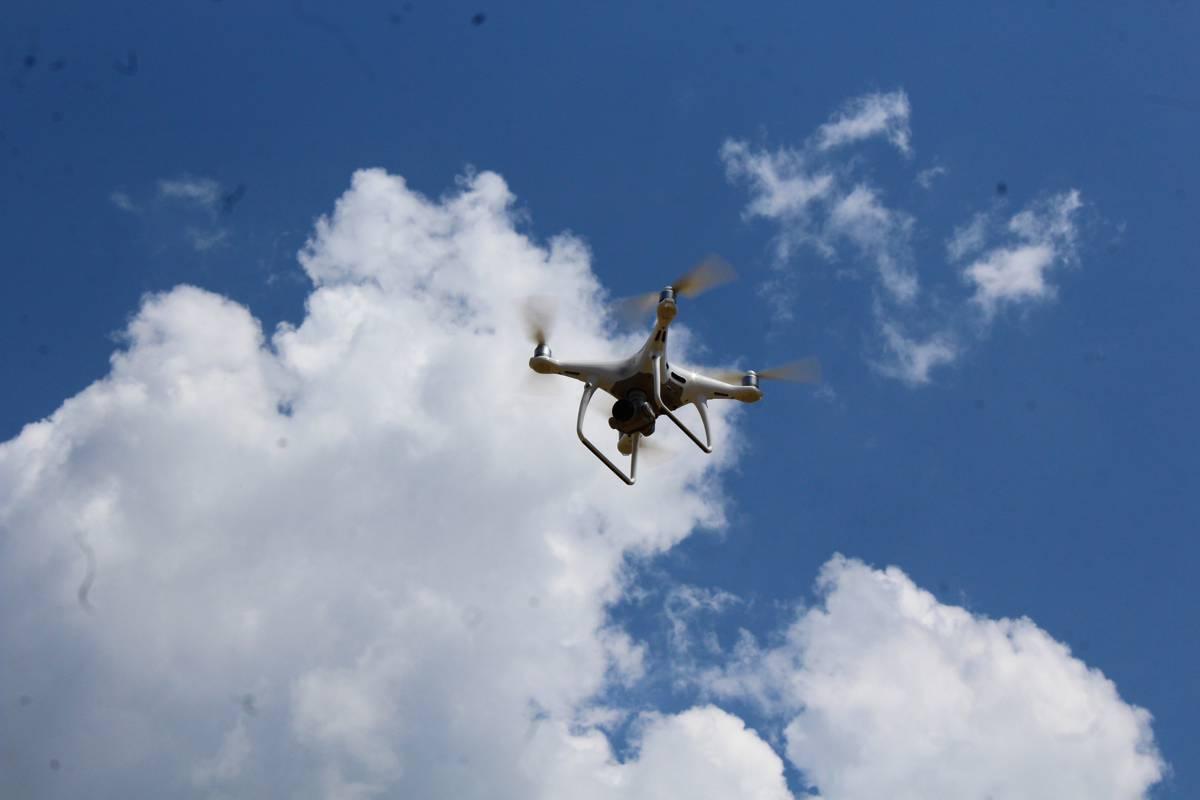GoldenEye Project gathers ground based data at Bulgarian Copper Ore Quarry
27/06/22-FR-English-NL-footer
Le projet GoldenEye recueille des données au sol sur la carrière bulgare de minerai de cuivre
 L'équipe d'EOS Data Analytics s'est rendue dans une carrière de minerai de cuivre à Panagyurishte, en Bulgarie, et a recueilli des données au sol pour valider la technologie de surveillance par satellite pour la plateforme d'IA développée dans le cadre du projet GoldenEye EU H2020 de trois ans pour l'industrie minière européenne.
L'équipe d'EOS Data Analytics s'est rendue dans une carrière de minerai de cuivre à Panagyurishte, en Bulgarie, et a recueilli des données au sol pour valider la technologie de surveillance par satellite pour la plateforme d'IA développée dans le cadre du projet GoldenEye EU H2020 de trois ans pour l'industrie minière européenne.
EOSDA a également assisté à l'Assemblée générale du projet. L'événement a eu lieu les 30 et 31 mai dans la capitale bulgare, Sofia, et a réuni 16 entreprises et partenaires de recherche pour partager des mises à jour sur leurs travaux.
GoldenEye implique le développement d'une plateforme d'analyse pour surveiller et analyser les sites miniers à travers l'UE afin d'améliorer leur productivité et la sécurité des travailleurs et de réduire l'impact environnemental de l'extraction.
La plate-forme, alimentée par des algorithmes d'apprentissage automatique, combine les technologies d'observation de la Terre avec la détection sur site : elle traite les données des satellites, des drones et des capteurs au sol et extrait des informations exploitables sur les sites miniers. De cette façon, la plateforme d'IA soutient la prise de décision à toutes les étapes du cycle de vie de la mine, de l'exploration à l'extraction et à la post-fermeture.
Dans le cadre du programme GoldenEye, EOS Data Analytics assure le traitement des données satellitaires. Notamment, les spécialistes sont en charge du suivi écologique sur de nombreux indicateurs, tels que l'évaluation de la stabilité des pentes, l'attribution des zones d'extraction active, l'humidité et la température de surface, et l'état de la végétation des territoires adjacents. Ils évaluent également la dynamique des changements de surface d'eau dans les résidus.
 « GoldenEye est un projet unique dont la mise en œuvre nécessite la synergie de nombreux acteurs et l'utilisation de technologies de pointe comme la surveillance par satellite. Pour analyser l'imagerie satellitaire, EOSDA utilise diverses approches de traitement d'image, notamment des algorithmes d'apprentissage automatique et d'apprentissage en profondeur. Toutes les méthodes ne fonctionnent pas de la même manière dans le monde et avec tous les types de minéraux. Par conséquent, nous ne pouvons pas nous passer de l'aperçu visuel d'une zone et de la collecte de données au sol. Nous en avons besoin pour calibrer et valider les résultats obtenus à partir des satellites. Un ajout intéressant au voyage était le fait que la carrière de Panagyurishte est située dans une région culturelle et historique de la Bulgarie : il y a des dizaines de tumulus thraces », note le Dr Nataliia Borotkanych, coordinatrice de projets chez EOS Data Analytics.
« GoldenEye est un projet unique dont la mise en œuvre nécessite la synergie de nombreux acteurs et l'utilisation de technologies de pointe comme la surveillance par satellite. Pour analyser l'imagerie satellitaire, EOSDA utilise diverses approches de traitement d'image, notamment des algorithmes d'apprentissage automatique et d'apprentissage en profondeur. Toutes les méthodes ne fonctionnent pas de la même manière dans le monde et avec tous les types de minéraux. Par conséquent, nous ne pouvons pas nous passer de l'aperçu visuel d'une zone et de la collecte de données au sol. Nous en avons besoin pour calibrer et valider les résultats obtenus à partir des satellites. Un ajout intéressant au voyage était le fait que la carrière de Panagyurishte est située dans une région culturelle et historique de la Bulgarie : il y a des dizaines de tumulus thraces », note le Dr Nataliia Borotkanych, coordinatrice de projets chez EOS Data Analytics.
Cinq sites miniers en Allemagne, Finlande, Roumanie, Bulgarie et Kosovo ont été choisis pour piloter la plateforme GoldenEye. Les participants terminent la collecte, le traitement et l'analyse des données. L'étape suivante consiste à tester la plate-forme pour s'assurer qu'elle est prête à être déployée.
NJC.© Info EOS Data Analytics
--------------------------------------------------------------------------------------------------------------------
27/06/22-English
GoldenEye Project gathers ground based data at Bulgarian Copper Ore Quarry
 The EOS Data Analytics team went to a copper ore quarry in Panagyurishte, Bulgaria, and gathered ground-based data to validate the satellite monitoring technology for the AI platform developed within the three-year GoldenEye EU H2020 project for the European mining industry.
The EOS Data Analytics team went to a copper ore quarry in Panagyurishte, Bulgaria, and gathered ground-based data to validate the satellite monitoring technology for the AI platform developed within the three-year GoldenEye EU H2020 project for the European mining industry.
EOSDA also attended the project’s General Assembly. The event took place on May 30–31 in the Bulgarian capital, Sofia, and brought together 16 companies and research partners to share updates on their work.
GoldenEye entails developing an analytics platform for monitoring and analysing mine sites across the EU to improve their productivity and worker safety and reduce the environmental impact of extraction.
The platform, powered by machine learning algorithms, combines earth observation technologies with on-site sensing: It processes data from satellites, drones, and ground-based sensors and extracts actionable intelligence about mining sites. That way, the AI platform supports decision-making at all stages of the mine’s life cycle, from exploration to extraction and post-closure.
Under the terms of the GoldenEye program, EOS Data Analytics is providing satellite data processing. Notably, the specialists are in charge of ecological monitoring on numerous indicators, such as the assessment of slope stability, allocation of areas of active extraction, humidity and surface temperature, and vegetation condition of adjacent territories. They also evaluate the dynamics of changes in water surface area in tailings.
 “GoldenEye is a unique project, implementation of which requires the synergy of many participants and the use of cutting-edge technologies like satellite monitoring. To analyse satellite imagery, EOSDA uses various image processing approaches, including machine learning and deep learning algorithms. Not all methods work the same around the world and with all types of minerals. Therefore, we can’t go without an area’s visual overview and ground data collection. We need them to calibrate and validate results obtained from satellites. An interesting addition to the trip was the fact that the Panagyurishte quarry is located in a cultural and historical region of Bulgaria: there are dozens of Thracian burial mounds,” notes Dr. Nataliia Borotkanych, Projects Coordinator at EOS Data Analytics.
“GoldenEye is a unique project, implementation of which requires the synergy of many participants and the use of cutting-edge technologies like satellite monitoring. To analyse satellite imagery, EOSDA uses various image processing approaches, including machine learning and deep learning algorithms. Not all methods work the same around the world and with all types of minerals. Therefore, we can’t go without an area’s visual overview and ground data collection. We need them to calibrate and validate results obtained from satellites. An interesting addition to the trip was the fact that the Panagyurishte quarry is located in a cultural and historical region of Bulgaria: there are dozens of Thracian burial mounds,” notes Dr. Nataliia Borotkanych, Projects Coordinator at EOS Data Analytics.
Five mining sites in Germany, Finland, Romania, Bulgaria, and Kosovo were chosen for piloting the GoldenEye platform. The participants are finishing collecting, processing, and analyzing data. The next step is to test the platform to ensure it’s ready for deployment.
NJC.© Info EOS Data Analytics
--------------------------------------------------------------------------------------------------------------------
27/06/22-NL
GoldenEye Project verzamelt gegevens op de grond in de Bulgaarse koperertsgroeve
 Het EOS Data Analytics-team ging naar een koperertsgroeve in Panagyurishte, Bulgarije, en verzamelde gegevens op de grond om de satellietbewakingstechnologie te valideren voor het AI-platform dat is ontwikkeld binnen het driejarige GoldenEye EU H2020-project voor de Europese mijnbouwindustrie.
Het EOS Data Analytics-team ging naar een koperertsgroeve in Panagyurishte, Bulgarije, en verzamelde gegevens op de grond om de satellietbewakingstechnologie te valideren voor het AI-platform dat is ontwikkeld binnen het driejarige GoldenEye EU H2020-project voor de Europese mijnbouwindustrie.
EOSDA woonde ook de Algemene Vergadering van het project bij. Het evenement vond plaats op 30-31 mei in de Bulgaarse hoofdstad Sofia, en bracht 16 bedrijven en onderzoekspartners samen om updates over hun werk te delen.
GoldenEye omvat de ontwikkeling van een analyseplatform voor het monitoren en analyseren van mijnsites in de hele EU om hun productiviteit en veiligheid van werknemers te verbeteren en de milieu-impact van winning te verminderen.
Het platform, aangedreven door machine learning-algoritmen, combineert technologieën voor aardobservatie met on-site sensing: het verwerkt gegevens van satellieten, drones en op de grond gebaseerde sensoren en extraheert bruikbare informatie over mijnsites. Op die manier ondersteunt het AI-platform de besluitvorming in alle stadia van de levenscyclus van de mijn, van exploratie tot winning en na sluiting.
Onder de voorwaarden van het GoldenEye-programma biedt EOS Data Analytics de verwerking van satellietgegevens. De specialisten zijn met name verantwoordelijk voor ecologische monitoring van tal van indicatoren, zoals de beoordeling van de stabiliteit van de hellingen, de toewijzing van gebieden met actieve extractie, vochtigheid en oppervlaktetemperatuur, en de vegetatieconditie van aangrenzende gebieden. Ze evalueren ook de dynamiek van veranderingen in het wateroppervlak in residuen.
 “GoldenEye is een uniek project, waarvan de uitvoering de synergie van veel deelnemers en het gebruik van geavanceerde technologieën zoals satellietmonitoring vereist. Om satellietbeelden te analyseren, gebruikt EOSDA verschillende benaderingen voor beeldverwerking, waaronder machine learning en deep learning-algoritmen. Niet alle methoden werken overal ter wereld en met alle soorten mineralen hetzelfde. Daarom kunnen we niet zonder het visuele overzicht van een gebied en het verzamelen van grondgegevens. We hebben ze nodig om de resultaten van satellieten te kalibreren en te valideren. Een interessante toevoeging aan de reis was het feit dat de steengroeve Panagyurishte zich in een culturele en historische regio van Bulgarije bevindt: er zijn tientallen Thracische grafheuvels”, merkt Dr. Nataliia Borotkanych op, Projects Coordinator bij EOS Data Analytics.
“GoldenEye is een uniek project, waarvan de uitvoering de synergie van veel deelnemers en het gebruik van geavanceerde technologieën zoals satellietmonitoring vereist. Om satellietbeelden te analyseren, gebruikt EOSDA verschillende benaderingen voor beeldverwerking, waaronder machine learning en deep learning-algoritmen. Niet alle methoden werken overal ter wereld en met alle soorten mineralen hetzelfde. Daarom kunnen we niet zonder het visuele overzicht van een gebied en het verzamelen van grondgegevens. We hebben ze nodig om de resultaten van satellieten te kalibreren en te valideren. Een interessante toevoeging aan de reis was het feit dat de steengroeve Panagyurishte zich in een culturele en historische regio van Bulgarije bevindt: er zijn tientallen Thracische grafheuvels”, merkt Dr. Nataliia Borotkanych op, Projects Coordinator bij EOS Data Analytics.
Vijf mijnsites in Duitsland, Finland, Roemenië, Bulgarije en Kosovo werden gekozen voor het testen van het GoldenEye-platform. De deelnemers zijn bezig met het verzamelen, verwerken en analyseren van gegevens. De volgende stap is om het platform te testen om er zeker van te zijn dat het klaar is voor implementatie.
NJC.© Info EOS Data Analytics
-----------------------------------------------------------------------------------------------------------------
















